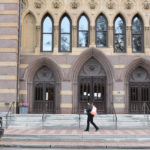BOE discusses 2020-21 magnet school lottery results, non-magnet school reputations
The Board discussed how to improve NHPS’s school choice lottery program and change negative perceptions of non-magnet schools.

Courtesy of NHPS
The question of just who deserves a spot at New Haven’s choice schools attracts annual debate in the months following the citywide school-choice lottery.
This year, that lottery took place in early March, and the results were announced on April 2. At Monday’s Board of Education meeting, New Haven Public Schools officials and board members discussed the plethora of complaints from district parents whose children did not receive spots at their preferred schools. In response to the parent feedback, the board discussed the growing gap between “desired” and “less-desired” schools, along with possible changes it could make to the existing lottery policy.
School choice policy is at the center of district efforts to ensure racial, ethnic and economic diversity within its schools. The city has used its magnet school program to promote these forms of diversity, inviting both NHPS and out-of-district parents to apply for 15 inter-district schools. NHPS families can also choose from citywide magnet schools, neighborhood schools and charter schools.
“This year I was one of the people who had to navigate the lottery,” board member Tamiko Jackson-McArthur said. “It was a pretty seamless process. … I thought you guys did a great job with the virtual pieces.”
Marquelle Middleton, New Haven Public Schools’ director of school choice, presented to the board on the district’s successful adaptation of the school choice lottery program to a virtual format. He labeled the smooth transition a “notable win.” This year, the city’s magnet schools participated in a virtual school choice expo. He also praised the district’s partnership with Princeton University on a “School Explorer Tool,” which offered parents virtual tours of schools and a rough estimate of how likely their child was to receive a spot at each of their selected schools. Middleton said that other successes included working with school counselors on school choice guidance and launching a survey to help students find schools that best fit their academic interests.

However, Middleton said that there are still areas for improvement. He added that parents still need support in selecting the “right” school for their child. He also said that some lottery schools and grades have no waitlists for the upcoming school year. He pointed out that pre-K enrollment at the inter-district magnet schools is substantially down from last year’s numbers, which has led to open seats at schools like Brennan-Rogers Magnet School in West Rock.
The district’s data shows that the number of New Haven resident and non-resident lottery applicants was down this cycle compared to last year.
This year, 64 percent of applicants were placed at one of their top six school choices during the initial placement round on April 2. Out of this pool, 56 percent of students were matched to their first-choice schools.
Board members talked about the 36 percent parents of students who did not receive a placement. Many said they had heard from upset parents about having to enroll their child at “undesirable” schools.

Board member Darnell Goldson said that he had recently received a call from a district father whose daughter was not accepted into any of the six lottery schools the family had ranked in their application.
Goldson said he was sad to hear that the father would not send his daughter to her designated neighborhood school, James Hillhouse High School. He said that it is unfortunate that there is a perception of many neighborhood schools as completely undesirable.
Board member Matt Wilcox agreed with Goldson that there is a perception problem with Hillhouse. He called for the district to take steps to improve the image of the school, beginning with an upgrade to the school’s website.
Jackson-McArthur said she believes the negative perception that cloaks Hillhouse to be a “racial issue,” suggesting that the school is seen as “the Black high school and unfortunately makes people feel some type of way.”
According to the National Center for Education Statistics, about 56.23 percent of the school population was Black for the 2019-20 school year.
District Superintendent Iline Tracey stated that Hillhouse’s negative reputation also applies to several of the district’s neighborhood elementary schools. She said that the district has funneled “a lot of dollars” into these schools for marketing and added that more work must be done to make all NHPS schools “desirable.”
NHPS operates a total of 44 schools.









